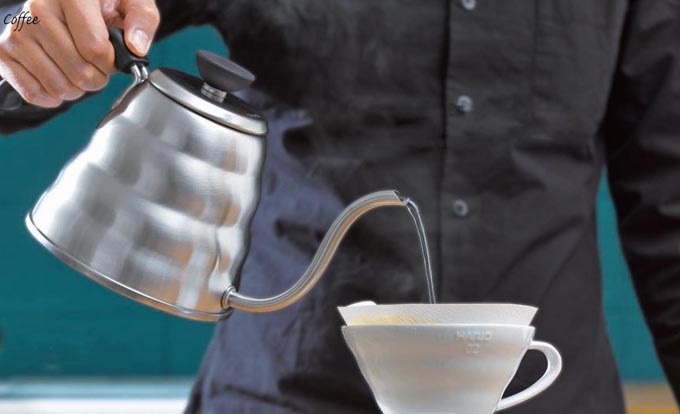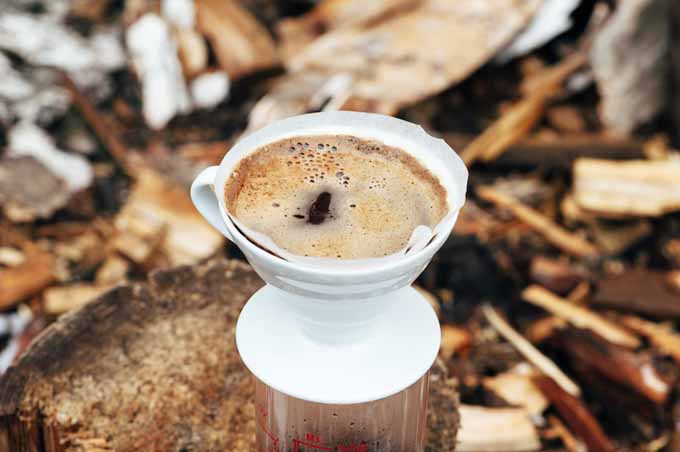It’s very simple to make terrific coffee right at home that will rival that served at any good coffee joint (and by good, I don’t mean the ubiquitous little mermaid).

Crafting a precise, well-balanced, nuanced cup of coffee instead of a mucky sour or flat liquid is made possible through focusing on the specifics of the processes at work. One of the key variables is that of the coffee “bloom.”
What Causes a Coffee Bloom?
The bloom is caused by the roasting procedure. Whenever all types of organic material are heated, chemicals – carbon dioxide in particular – are discharged.
Following roasting, most of these gases are released little by little. This effect is referred to as “degassing.”
When you’re using coffee roasted inside of a ten day window, the coffee retains carbon dioxide along with other volatile compounds which, while still in an intact coffee bean, expel gas gradually.
A soon as the beans are ground, the trapped gases are discharged much more quickly. Moreover, when hot water touches the coffee grounds, they immediately purge themselves of the carbon dioxide and create the “bloom.”
When triggering the blooming process, the effects of out-gassing can be observed as the coffee grounds puff up when they come in contact with the hot water.

The formerly trapped gases now emerge at a much faster rate, applying pressure to the outside and repelling the water that must enter in order to draw out the volatile compounds that provide flavor and texture.
This effect is also known as turbulence. If water doesn’t have adequate exposure to the grounds, the extraction will likely be weak. By blooming initially, we’re basically waiting so that the coffee can make space for water.
Fresh Roasted and Ground Coffee Makes a Difference
The bean’s normal loss of carbon dioxide and other gasses begins as soon as it is roasted, and carries on for a couple of weeks following the roast.
However, the majority of the contained gasses will be reduced more rapidly inside the first week. Many of the volatile compounds found within the gasses are what brings flavor to our coffee, and we want to keep as many of these intact as possible.
It is very important to note that grinding the beans instantly raises the surface area to enable a much faster velocity of gas reduction. Therefore, this is why true coffee aficionados and cafes will not grind until right before they are going to brew.
Need help selecting a grinder? Read Foodal’s Grinder Buying Guide. And why not try roasting your own beans at home for the ultimate in freshness?
Storage of Coffee Beans Makes a Difference
Other factors affect the rate of gas loss as well. Packaging and storage both play a vital role in this.
Many coffee buffs use airtight containers to store their coffee beans. There are two schools of thought on this:
The first is to use the escaping gases to increase pressure within the container, which serves to hamper the rate of gas escaping from the beans.
The second is to include a one-way pressure relief valve, which serves to allow the escaping gases out but no other outside gases in, creating somewhat of a vacuum effect.
Of course, packaged fresh coffee normally contains these relief valves. They are usually vacuum packed from the roaster and any new gasses would seek to pop the sealing loose.
Other Variables Affecting the Bloom
Other factors include:
- Temperatures that the beans were stored at. Hotter means more gas release.
- Humidity levels during storage. Dryer levels allow more gas to escape. Of course, high humidity levels may encourage mold and fungus growth, so you need to find a happy medium.
- Bean hardness. Harder beans mean more density for the gas to make its way through.
- Roast levels. Roast level will have a significant influence on bloom. Extremely dark and oily Italian roasts have a much smaller amount of out-gassing compared to the exact same coffee roasted at the “Full City” level.
- Origin. Coffees grown in some regions are known to have more out-gassing than others.
Bottom Line – if the coffee does not bloom at all, it is usually stale and/or over roasted (the little mermaid is guilty of both).
TIP
Many home coffee buffs freeze their beans in order to keep most of the freshness intact. Read more about how to store your beans to maximize freshness.
How to Bloom
The basic blooming process merely involves adding hot water to the coffee grinds so that they become damp a minute or two prior to initiating the main extraction process.

There are as many techniques for this as there are coffee aficionados, but we’ve outlined a few basic techniques and tips for a variety of brewing methods below.
Blooming for Pour Overs
Pour 40-80 grams of very hot (but not boiling) water over the coffee grounds, using a circular motion starting from the outside wall and working your way inward.
Ensure the grounds end up uniformly soaked but not dripping wet. Allow this to sit for about a minute. For Chemex Coffeemakers, see our review which includes brewing tips.
Blooming For French Presses
Gently pour a small quantity of hot water onto the coffee grounds (which should be a coarse grind). You should immediately notice a bloom start to form as foam on top of the water in the press-pot.
Let the bloom remain for 15-20 seconds, then stir it with your spoon. This is to ensure that all grinds in the bloom have complete contact with the water.
Complete your normal French press brew regime, which normally involves 3-4 minutes of steeping time.
Blooming For Automatic Drip Coffee Makers
Begin by placing your filter in the coffeemaker’s basket. We prefer to use good quality filters such as the Melitta or Filtropa brands. Using quality filters will ensure that most sludge and ill flavored oils do not reach your coffee brew and are also stronger, preventing filter breakage accidents.
The next step is to add your fresh roasted and ground coffee beans and then pour in your hot water – just enough to soak the grounds without pouring through.
Wait 45-90 seconds, permitting the grinds to settle, and then simply operate the automatic coffeemaker as you normally would.
What you may discover is that, at the conclusion of the brewing extraction cycle, there aren’t any depressions where the water drip hit. Rather, the water is going to pool on top of the grinds and then soak all the way through, similar to whenever it rains on a clay type of soil.
This provides you with a much more even extraction, and therefore far better coffee.
TIP: There are several premium automatic drip coffee pots that you can configure to bloom the coffee for you – some of these include the:
- Breville BDC400 / BDC450 Precision Brewers
- Cuisinart CPO-800 and CPO-850 PurePrecision Brewers
- Behmor Brazen Plus Temperature Control Brew System
- KitchenAid KCM0802
- KitchenAid Pour Over Brewer (model KCM0801OB)
- Bonavita Model BV1900TS
- BUNN 10-Cup Programmable Coffeemaker
- OXO On 9-Cup
- OXO On 12-Cup
- Technivorm Moccamaster
Be sure to check out Foodal’s Drip Coffee Maker Buying Guide for more information about these special brewers.
No matter your brewing technique, with fresh roasted and ground coffee, I guarantee that you will notice a better taste in your cup if you follow a simple coffee blooming technique.
And be sure to take a look at the variety of carafes you can purchase to keep your coffee hot.
Don’t be afraid to experiment a little with soak times, etc. and find the method that works best for you.
About Mike Quinn
Mike Quinn spent 20 years in the US Army and traveled extensively all over the world. As part of his military service, Mike sampled coffee and tea from all virtually every geographic region, from the beans from the plantation of an El Salvadorian Army Colonel to "Chi" in Iraq to Turkish Coffee in the Turkish Embassy in Kabul, Afghanistan. He spent nearly a decade in the Republic of Korea where he was exposed to all forms of traditional teas. Mike formerly owned and operated Cup And Brew, an online espresso and coffee equipment retail operation.




I’ve actually read about this before, but promptly forgot to try it out. I think there’s a better chance I’ll try it when using my french press, since I’m really impatient for the first cup in the morning (drip), to wake me up. I’m interested to see if I can taste the difference, and if I can, I might have to slow down a bit, and try it with the drip coffee maker.
Great article, Mike. It definitely makes a difference. I didn’t think it would matter as much as it does.
Since I got my French Press, I’ve been learning a lot more about how to properly prepare my favorite beverage. I have been enjoying my morning java a lot more.
Nice tips and instructions. Thanks for explaining why and how this is done.
Autodrip:
1. Make sure you have the “no drip” type basket.
2. Leave the pot out.
3. Set up your coffee to go the normal way.
4. Turn it on and let the brew start without the pot in to catch the coffee
5. Let the basket fill, stir with a fork taking care not to puncture your filter.
6 When just about full to overflow put the pot back in and watch the coffee stream in.
7. It doesn’t take more time than it would have normally but tastes way better.
8. You can even pull the pot out again and make the basket fill a second time to get every drop of flavor.
9. Enjoy
Well I have to say that I am pretty avid coffee drinker, and have been for some time now, and this is the first that I am hearing of a coffee bloom. That said, though, I must say that I am completely intrigued and I am all in on finding the ways that I can make this happen. Perhaps I already have, and I know that some days my homemade coffee is great, and maybe a bloom, but other days it can struggle. Thanks for sharing.
I don’t see that pre-blooming my coffee makes any difference for a French press. You pour in the water, wait 20 seconds and stir. Then you skim off the fines if you find it necessary. For other methods of coffee making that have a very short contact time with the water, I see your point, but in a French press, the grounds are larger and the water has minutes to extract the solids.
It certainly makes a difference.
That’s a great point. Serious Eats agrees: “It’s really applicable only in a pourover setup, where the water travels continuously through the ground beans, giving them a limited shot at extracting flavor. (Beans degas when they’re steeped as well, such as in a French press, but since they continue to linger in the water for the duration of the brewing phase, there’s still plenty of time to get more flavor out.)”
(seriouseats dot com/2018/07/the-hows-and-whys-of-blooming-coffee.html)
hi all!
im vietnamese, my english is not good!
so i have a question ! when i bloom ground coffee . First, i use 20gr coffee and 40 ml hot water and i weighing volum ,total is 56 gr … but 5 minute last, i weight again is ~53 -54gr . it loss 2 gr ???? and WHY ???
can y help me to answer ??
We have a Viking Professional Coffee Maker and have had several issues. The unit would not reset from a DCL fault (replaced with new unit under warranty) and currently it will not work – it is dead. This is very concerning not only because of the purchase price but the repair costs are high. This unit is only 2 years old (yes out of warranty). Mr coffee is looking better???? What are your thoughts?
I personally use a Brazen Plus (https://foodal.com/drinks-2/coffee/brewers/behmor-brazen-brewer/) day to day but have each of the ones we reviewed in my possession. For the absolute highest quality and one that will last years (but pricey), the Moccomaster is definitely an option: https://foodal.com/drinks-2/coffee/brewers/technivorm-moccamaster-best-of-breed/.
You can see our suggested models here: https://foodal.com/drinks-2/coffee/brewers/best-drip-makers-reviewed/
Mike,
Thanks for two contributions. Firstly, for your 20 years of service on behalf of us all. I, too, have traveled in many countries and had those opportunities to enjoy so many different coffees — a great benefit of w/w travel!
Secondly, thanks for the excellent and most informative article! I have been making good coffee for over 50 years; and I learned several facts that will most certainly enhance my coffee!
Kind regards,
Peter – Three Forks, Montana
Your social share panel obscures the left side of the article.
This has been a common complaint lately. Thanks for your input, Tom! To improve user experience, we have temporarily disabled the sidebar, until a fix is implemented that does not obscure the text.
useful advice
I roast coffee. All over the place websites recommend degassing in a bag with a one -way valve. I would like to ask something. I put the freshly roasted coffee into a jar with a loosely placed cap. Degassing happens. CO2 is heavier than oxygen and nitrogen and of air. So it is not displaced. How is it better if I go to the expense and trouble of the one way valve? Thx
Do you roast your coffee in large batches, or in small ones that can be used up quickly? Do you leave any headspace at the top of the jar? As I’m sure you know, enjoying the best quality freshly roasted coffee is a race against time. One-way valves allow for the release of the CO2 that’s off-gassed after roasting without allowing more oxygen in. When freshly roasted beans are oxidized, they become stale more quickly (and this happens many times more quickly after roasted beans are ground, since this increases the surface area of the coffee dramatically). CO2 does slow the effects of oxidation and it is heavier than oxygen, but a loose cap will allow for some exchange of air and resulting oxidation, as opposed to a vacuum sealed package with a one-way valve.
Blooming 100% changes it, same with using fresh beans. I love coffee and started enjoying it plain with a little cream when I was like 18. Over time I started to realize that some coffee upset my stomach (acid), some coffee just tastes bad to me and also gave me headaches (sorry Folgers). I started buying fresh beans, got rid of my drip machine, got a French press… grind before steeping, allowing the bloom, buying quality beans (local and Starbucks). I fell way more in love with coffee. I even drink decaf. Best wishes to all my coffee fiends. May your cup be delicious, full bodied and give you happy warm fuzzys ????.